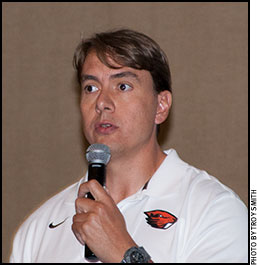Minimize Three Main Types of Stress
Physiologic, physical and psychological stress can reduce reproductive success.
 The definition of stress is the sum of reactions that influence an animal’s homeostasis, explained Reinaldo Cooke, associate professor at Oregon State University. Cooke detailed the implications stress may have on female reproductive systems on Aug. 29 at the 2017 Applied Reproductive Strategies in Beef Cattle (ARSBC) symposium in Manhattan, Kan.
The definition of stress is the sum of reactions that influence an animal’s homeostasis, explained Reinaldo Cooke, associate professor at Oregon State University. Cooke detailed the implications stress may have on female reproductive systems on Aug. 29 at the 2017 Applied Reproductive Strategies in Beef Cattle (ARSBC) symposium in Manhattan, Kan.
Cooke began by defining homeostasis as any action that takes you outside your comfort zone. Anything that takes you away from a comfort zone is a type of stressor. He described three main types of stress:
- Physiologic stress is when an animal gets sick or catches a disease.
- Physical stress is applied if an animal receives an injury.
- Psychological stress happens when an animal senses fear.
As soon as an animal is faced with stress, the body begins to produce cortisol at a higher rate than it produces epinephrine.

“There is a direct connection between cortisol levels and pregnancy conception rates,” said Reinaldo Cooke, associate professor at Oregon State University. “We must understand and recognize the three stressors and find an alternative to alleviate the stressors.”
While the body is producing high levels of cortisol during stress, it is also releasing key elements like creatine and sugars, which can be detrimental to the animal’s productivity, specifically the reproductive system’s productivity. With increased levels of cortisol, there is decreased follicle growth and estrogen levels, which can lead to a change in ovulation success, he said.
“There is a direct connection between cortisol levels and pregnancy conception rates,” said Cooke. “We must understand and recognize the three stressors and find an alternative to alleviate the stressors.”
Cooke said that nutrition could be considered a physiological stressor. If heifers are born on pasture and are moved to drylot systems after weaning, they experience a stressful change of environment. The pasture was considered their comfort zone, and they left homeostasis when they were moved to a crowded drylot pen.
“You must give their bodies a chance to adapt to the changes before breeding,” said Cooke.
Pregnancy rates fell after the heifers were bred in a drylot facility and turned out to pasture two weeks later.
“The animals didn’t know how to graze and their average daily gain dropped significantly,” said Cooke.
Relocating cattle between Day 7 and Day 21 can be detrimental to their pregnancy, he continued. Producers should consider avoiding major changes in diet and environment directly after breeding.
Cooke suggested utilizing trace minerals, sugars, amino acids and progesterone to alleviate nutritional stressors. Aim to keep body conditions healthy, not overly conditioned or too thin to avoid unnecessary stressors.
Temperament can be another factor in determining successful reproductive systems, he continued.
“Cows act excited or aggressive around humans because they’re not comfortable around us,” Cooke said. “They are trying to run away or run over us as a fight or flight response. Fear is a psychological stress.”
By studying and classifying females by temperament, Cooke’s research found that stressed or nervous cows weaned lighter calves. Weaning lighter calves led to a $52 decrease per cow, he said.
“Stress has direct implications on reproduction success,” Cooke said.
Cooke spoke during Tuesday’s ARSBC session focused on foundation principals. Visit the Newsroom at www.appliedreprostrategies.com, which features comprehensive coverage of the symposium, to view his PowerPoint, to read the proceedings or to listen to the presentation. Compiled by the Angus Journal editorial team, the site is made possible through sponsorship by the Beef Reproduction Task Force. To access video of the presentations, visit the Beef Reproduction Task Force page on Facebook.
The 2017 ARSBC Symposium was hosted by the Task Force and Kansas State University Research & Extension. Next year’s symposium will be Aug. 29-30 in Ruidoso, N.M.

Editor’s Note: Katy Holdener is the digital content manager for the American Angus Association.






